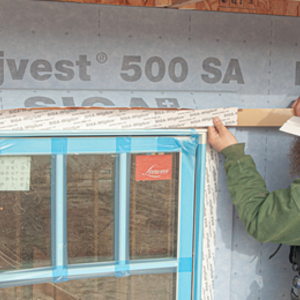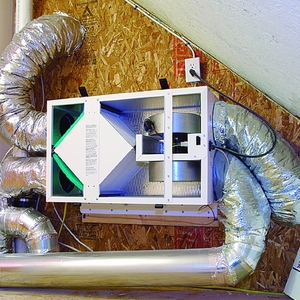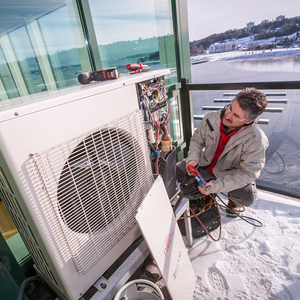
In 1973, a little less than half of all new single-family homes in the U.S. had mechanical air conditioning. By 2018, according to government statistics, only 7% of new homes lacked it, and in some parts of the country the number of non-AC houses was essentially zero.
The trend will continue. With global temperatures continuing to go up, air conditioning is becoming essential to an increasing number of people. Experts from the Rocky Mountain Institute project that the total number of residential air conditioners will rise from 900 million today to 3.7 billion by mid-century.
Despite the near universal expectation for AC in the U.S., cooling needs across the seven climate zones in the Lower 48 are anything but uniform. Temperature ranges are obviously very different from one region to the next, but so are humidity levels. Houses in Arizona and Florida may experience the same temperature on any given day, but they will be coping with very different moisture levels—one dry and hot, the other muggy and hot. Each presents a different cooling challenge.
Cooling strategies run all the way from a whole-house fan in the attic that flushes out hot indoor air at night to a fully-ducted mechanical system. In some parts of the country, AC is needed on only a few days each year. In others, life is miserable without it.
This survey of residential cooling equipment is an introduction, a look at the basics. There are scores of articles and much more detailed information elsewhere at Green Building Advisor, available by using the search function on GBA’s home page.
Start with a load calculation
As is the case with heating appliances, choosing the right AC equipment begins with an accurate calculation of cooling loads. That takes us back to Manual J, the worksheet developed for HVAC contractors by…
Weekly Newsletter
Get building science and energy efficiency advice, plus special offers, in your inbox.

This article is only available to GBA Prime Members
Sign up for a free trial and get instant access to this article as well as GBA’s complete library of premium articles and construction details.
Start Free TrialAlready a member? Log in















3 Comments
Great article. Pulls together a lot of valuable information on the subject and puts it in one coherent piece. Thanks!
Great article. I have a chiltrix air/water heat pump, and I am having trouble now in cooling mode.
Out door unit is CX 34-2. I ran 1" pex water lines, insulated 3/4" foam inside, and 2 courses of insulation outside. I ran a manual J through CoolCalc, and I worked with John at Hotspot Energy to get the fan coils and the pipe run correct etc. Yeah, I did most of the work myself. I am in Central Maryland, a few miles south of 38.981 latitude. I used 91* F for design temperature, and we have certainly hit that mark already. I am trying to find out the cooling degree days for my location. I feel like I should have used 95*.
So, I have a 1 1/2 story house, stick built, 1927 approximate year of construction. Basement, first floor and partial upstairs, 352 sf, the building footprint is 900sf +/-. In June when the weather was cooler, I used to get operation of of both fcu's on 2nd floor, and reliably 51* water in the smaller unit. The 2nd larger one was usually 60* +/- water, still good enough for cooling. As the weather heats up the larger unit started shutting off more and more, and I found that when I bled air from the coil, I could get it to turn on again. So I installed an air bleed valve at that unit. At this same time, I had issues with the primary pump, and a flow sensor, all of which was replaced, of course involving draining the system, partially, and refilling. So now with new equipment, and hotter ambient temperatures and I am only getting 73* +/- water at the smaller unit, and the larger unit struggles to reach even 68*, the onset water temperature for cooling operation.
There is most definitely chill water getting to the smaller coil, I can see the condensation on the fittings, and I can feel it with my feet, but the coils still shows 70+ temperature and no action in cooling mode. I have routinely bled more air from these units, but the smaller one still does not run.
I don't know what to do now. I could increase the insulation of the pipe, but I'd have to tear the floor up to do that. It's a rough floor, but still, a big project. I could add a bleed valve to the smaller unit, but that has only marginally helped the larger one.
I have about 40 psi at the out door unit, system max is 45. Total rise is 20-25', I will check that. I am usually getting 4.5- 5.8 gpm flow from the primary and booster pump.
Do you have any thoughts on how to proceed?
Great article, and I'm glad you mentioned EER but I think it's worth doubling down on that, specifically because SEER is for a "typical cooling season", it's a one size fits all approach that completely ignores that there's 8 different climate zones in the US. I think it's therefore important that if you live in a hot climate like I do in Las Vegas that you look at both the SEER and EER. EER is measured when the temperature outside is 95. The SEER season uses temperatures above 87°F for only 7.4% of the cooling season. What I'd really like to see are regional SEER ratings for each climate zone. We have all the data, all it needs is the government to legislate for it. I've spelled out why I think that's necessary along with some example EERS at 115 degrees - which is not an uncommon temperate in the desert southwest: https://theheatpumpguy.com/f/its-time-for-individual-seer-ratings-for-all-8-us-climate-zones
Log in or become a member to post a comment.
Sign up Log in